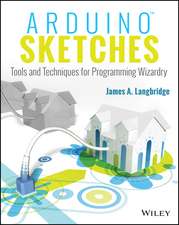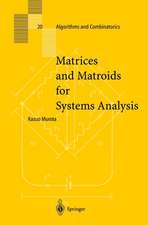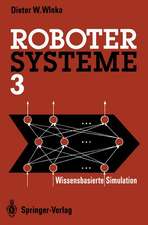Imperfect Bifurcation in Structures and Materials: Engineering Use of Group-Theoretic Bifurcation Theory: Applied Mathematical Sciences, cartea 149
Autor Kiyohiro Ikeda, Kazuo Murotaen Limba Engleză Paperback – 7 oct 2020
Systematic methods based on asymptotic, probabilistic, and group theoretic standpoints are used to examine experimental and computational data from numerous examples, such as soil, sand, kaolin, honeycomb, and domes. For mathematicians, static bifurcation theory for finite-dimensional systems, as well as its applications for practical problems, is illuminated by numerous examples. Engineers may find this book, with its minimized mathematical formalism, to be a useful introduction to modern bifurcation theory.
This third edition strengthens group representation and group-theoretic bifurcation theory. Several large scale applications have been included in association with the progress of computational powers. Problems and answers have been provided.
Review of First Edition:
"The book is unique in considering the experimental identification of material-dependent bifurcations in structures such as sand, Kaolin (clay), soil and concrete shells. … These are studied statistically. … The book is an excellent source of practical applications for mathematicians working in this field. … A short set of exercises at the end of each chapter makes the book more useful as a text. The book is well organized and quite readable for non-specialists."
Henry W. Haslach, Jr., Mathematical Reviews, 2003
| Toate formatele și edițiile | Preț | Express |
|---|---|---|
| Paperback (2) | 406.63 lei 6-8 săpt. | |
| Springer International Publishing – 7 oct 2020 | 406.63 lei 6-8 săpt. | |
| Springer – 5 noi 2012 | 511.19 lei 6-8 săpt. | |
| Hardback (1) | 521.50 lei 6-8 săpt. | |
| Springer International Publishing – 7 oct 2019 | 521.50 lei 6-8 săpt. |
Din seria Applied Mathematical Sciences
- 13%
 Preț: 426.94 lei
Preț: 426.94 lei - 13%
 Preț: 426.46 lei
Preț: 426.46 lei - 13%
 Preț: 427.63 lei
Preț: 427.63 lei - 9%
 Preț: 1728.59 lei
Preț: 1728.59 lei - 24%
 Preț: 906.80 lei
Preț: 906.80 lei - 23%
 Preț: 659.07 lei
Preț: 659.07 lei -
 Preț: 375.65 lei
Preț: 375.65 lei - 18%
 Preț: 909.47 lei
Preț: 909.47 lei - 18%
 Preț: 795.02 lei
Preț: 795.02 lei - 18%
 Preț: 950.52 lei
Preț: 950.52 lei - 15%
 Preț: 645.47 lei
Preț: 645.47 lei - 20%
 Preț: 755.49 lei
Preț: 755.49 lei -
 Preț: 382.67 lei
Preț: 382.67 lei - 24%
 Preț: 808.06 lei
Preț: 808.06 lei -
 Preț: 452.62 lei
Preț: 452.62 lei -
 Preț: 190.23 lei
Preț: 190.23 lei -
 Preț: 399.12 lei
Preț: 399.12 lei - 18%
 Preț: 966.90 lei
Preț: 966.90 lei - 15%
 Preț: 643.48 lei
Preț: 643.48 lei - 15%
 Preț: 528.80 lei
Preț: 528.80 lei -
 Preț: 413.15 lei
Preț: 413.15 lei -
 Preț: 390.25 lei
Preț: 390.25 lei - 18%
 Preț: 736.01 lei
Preț: 736.01 lei - 18%
 Preț: 1411.05 lei
Preț: 1411.05 lei - 15%
 Preț: 711.21 lei
Preț: 711.21 lei -
 Preț: 395.47 lei
Preț: 395.47 lei - 18%
 Preț: 1017.26 lei
Preț: 1017.26 lei -
 Preț: 403.15 lei
Preț: 403.15 lei - 18%
 Preț: 1130.14 lei
Preț: 1130.14 lei - 18%
 Preț: 1134.87 lei
Preț: 1134.87 lei - 18%
 Preț: 1329.00 lei
Preț: 1329.00 lei - 18%
 Preț: 1129.65 lei
Preț: 1129.65 lei - 18%
 Preț: 1140.71 lei
Preț: 1140.71 lei
Preț: 406.63 lei
Nou
Puncte Express: 610
Preț estimativ în valută:
77.81€ • 83.20$ • 64.88£
77.81€ • 83.20$ • 64.88£
Carte tipărită la comandă
Livrare economică 18 aprilie-02 mai
Preluare comenzi: 021 569.72.76
Specificații
ISBN-13: 9783030214753
ISBN-10: 3030214753
Pagini: 590
Ilustrații: XXV, 590 p. 239 illus., 33 illus. in color.
Dimensiuni: 155 x 235 mm
Greutate: 0.85 kg
Ediția:3rd ed. 2019
Editura: Springer International Publishing
Colecția Springer
Seria Applied Mathematical Sciences
Locul publicării:Cham, Switzerland
ISBN-10: 3030214753
Pagini: 590
Ilustrații: XXV, 590 p. 239 illus., 33 illus. in color.
Dimensiuni: 155 x 235 mm
Greutate: 0.85 kg
Ediția:3rd ed. 2019
Editura: Springer International Publishing
Colecția Springer
Seria Applied Mathematical Sciences
Locul publicării:Cham, Switzerland
Cuprins
Overview of Book.- Imperfect Behavior at Simple Critical Points.- Critical Points and Local Behavior.- Imperfection Sensitivity Laws.- Worst Imperfection (I).- Random Imperfection (I).- Experimentally Observed Bifurcation Diagrams.- Imperfect Bifurcation of Symmetric Systems.- Group-Theoretic Bifurcation Theory.- Bifurcation Behavior of Dn-Equivariant Systems.- Worst Imperfection (II).- Random Imperfection (II).- Description and Computation of Bifurcation Behaviors.- Efficient Transformation for Block-Diagonalization.- Modeling of Bifurcation Phenomena.- Bifurcation of Cylindrical Sand Specimens.- Echelon-Mode Formation.- Bifurcation of Steel Specimens.- Flower Patterns on Honeycomb Structures.- Answers to Problems.
Notă biografică
Kiyohiro Ikeda is a Professor in the Department of Civil Engineering, Graduate School of Engineering at Tohoku University. Kazuo Murota is a Professor in the Department of Mathematical Informatics, Graduate School of Information Science and Technology at University of Tokyo.
Textul de pe ultima copertă
This book provides a modern static imperfect bifurcation theory applicable to bifurcation phenomena of physical and engineering problems and fills the gap between the mathematical theory and engineering practice.
Systematic methods based on asymptotic, probabilistic, and group theoretic standpoints are used to examine experimental and computational data from numerous examples, such as soil, sand, kaolin, honeycomb, and domes. For mathematicians, static bifurcation theory for finite-dimensional systems, as well as its applications for practical problems, is illuminated by numerous examples. Engineers may find this book, with its minimized mathematical formalism, to be a useful introduction to modern bifurcation theory.
This third edition strengthens group representation and group-theoretic bifurcation theory. Several large scale applications have been included in association with the progress of computational powers. Problems and answers have been provided.
Review of First Edition:
"The book is unique in considering the experimental identification of material-dependent bifurcations in structures such as sand, Kaolin (clay), soil and concrete shells. … These are studied statistically. … The book is an excellent source of practical applications for mathematicians working in this field. … A short set of exercises at the end of each chapter makes the book more useful as a text. The book is well organized and quite readable for non-specialists."
Henry W. Haslach, Jr., Mathematical Reviews, 2003
Systematic methods based on asymptotic, probabilistic, and group theoretic standpoints are used to examine experimental and computational data from numerous examples, such as soil, sand, kaolin, honeycomb, and domes. For mathematicians, static bifurcation theory for finite-dimensional systems, as well as its applications for practical problems, is illuminated by numerous examples. Engineers may find this book, with its minimized mathematical formalism, to be a useful introduction to modern bifurcation theory.
This third edition strengthens group representation and group-theoretic bifurcation theory. Several large scale applications have been included in association with the progress of computational powers. Problems and answers have been provided.
Review of First Edition:
"The book is unique in considering the experimental identification of material-dependent bifurcations in structures such as sand, Kaolin (clay), soil and concrete shells. … These are studied statistically. … The book is an excellent source of practical applications for mathematicians working in this field. … A short set of exercises at the end of each chapter makes the book more useful as a text. The book is well organized and quite readable for non-specialists."
Henry W. Haslach, Jr., Mathematical Reviews, 2003
Caracteristici
Exercises at the ends of chapters or sections Solutions to selected exercises in the book Detailed Illustrations
Recenzii
From the reviews:
MATHEMATICAL REVIEWS
"The book is an excellent source of practical applications for mathematicians working in this field. It fulfills its goal of helping close the gap between mathematical and engineering practice in bifurcation analysis, especially of geomaterials such as sand and soil. A short set of exercises at the end of each chapter makes the book more useful as a text. The book is well organized and quite readable for non-specialists."
"The present book gives a wide and deep description of imperfect bifurcation behaviour in engineering problems. … the book offers a number of systematic methods based on contemporary mathematics. … On balance, the reviewed book is very useful as it develops a modern static imperfect bifurcation theory and fills the gap between mathematical theory and engineering practice." (Boris V. Loginov, Zentralblatt MATH, Vol. 1005, 2003)
"The book is unique in considering the experimental identification of material-dependent bifurcations in structures such as sand, Kaolin (clay), soil and concrete shells. … These are studied statistically. … The book is an excellent source of practical applications for mathematicians working in this field. … A short set of exercises at the end of each chapter makes the book more useful as a text. The book is well organized and quite readable for non-specialists." (Henry W. Haslach, Jr., Mathematical Reviews, Issue 2003 f)
"The current book is a graduate-level text that presents an overview of imperfections and the prediction of the initial post-buckling response of a system. … Imperfect Bifurcation in Structures and Materials provides an extensive range of material on the role of imperfections in stability theory. It would be suitable for a graduate-level course on the subject or as a reference to research workers in the field." (J Petrolito, Applied Mechanics Reviews, Vol. 56 (3), 2003)
"This book is a comprehensive treatment ofthe static bifurcation problems found in (mainly civil/structural) engineering applications. … The text is well written and regularly interspersed with illustrative examples. The mathematical formalism is kept to a minimum and the 194 figures break up the text and make this a highly readable and informative book. … In summary a comprehensive treatment of the subject which is very well put together and of interest to all researchers working in this area: recommended." (David Wagg, UK Nonlinear News, November, 2002)
From the reviews of the second edition:
“The book provides a modern theory of imperfect bifurcation phenomena in physical and engineering problems. … the reviewed book can be useful in developing a modern imperfect bifurcation theory. Additionally, the book can also be considered as a reliable bridge between the mathematical theory and engineering practice.” (Boris V. Loginov, Zentralblatt MATH, Vol. 1204, 2011)
MATHEMATICAL REVIEWS
"The book is an excellent source of practical applications for mathematicians working in this field. It fulfills its goal of helping close the gap between mathematical and engineering practice in bifurcation analysis, especially of geomaterials such as sand and soil. A short set of exercises at the end of each chapter makes the book more useful as a text. The book is well organized and quite readable for non-specialists."
"The present book gives a wide and deep description of imperfect bifurcation behaviour in engineering problems. … the book offers a number of systematic methods based on contemporary mathematics. … On balance, the reviewed book is very useful as it develops a modern static imperfect bifurcation theory and fills the gap between mathematical theory and engineering practice." (Boris V. Loginov, Zentralblatt MATH, Vol. 1005, 2003)
"The book is unique in considering the experimental identification of material-dependent bifurcations in structures such as sand, Kaolin (clay), soil and concrete shells. … These are studied statistically. … The book is an excellent source of practical applications for mathematicians working in this field. … A short set of exercises at the end of each chapter makes the book more useful as a text. The book is well organized and quite readable for non-specialists." (Henry W. Haslach, Jr., Mathematical Reviews, Issue 2003 f)
"The current book is a graduate-level text that presents an overview of imperfections and the prediction of the initial post-buckling response of a system. … Imperfect Bifurcation in Structures and Materials provides an extensive range of material on the role of imperfections in stability theory. It would be suitable for a graduate-level course on the subject or as a reference to research workers in the field." (J Petrolito, Applied Mechanics Reviews, Vol. 56 (3), 2003)
"This book is a comprehensive treatment ofthe static bifurcation problems found in (mainly civil/structural) engineering applications. … The text is well written and regularly interspersed with illustrative examples. The mathematical formalism is kept to a minimum and the 194 figures break up the text and make this a highly readable and informative book. … In summary a comprehensive treatment of the subject which is very well put together and of interest to all researchers working in this area: recommended." (David Wagg, UK Nonlinear News, November, 2002)
From the reviews of the second edition:
“The book provides a modern theory of imperfect bifurcation phenomena in physical and engineering problems. … the reviewed book can be useful in developing a modern imperfect bifurcation theory. Additionally, the book can also be considered as a reliable bridge between the mathematical theory and engineering practice.” (Boris V. Loginov, Zentralblatt MATH, Vol. 1204, 2011)



















